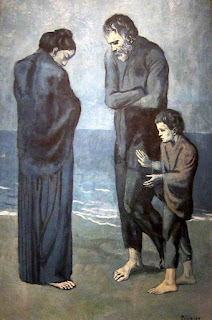Portrait de Paul Eluard 1929. Salvador Domingo Felipe Jacinto Dalí
b.1904 d.1989 Spanish surrealist painter and sculptor. Sold at Sotheby's in 2011 for $22.4 Million
Dollars.
At the age of six Salvador Dali wanted to be a cook, at seven he wanted to be Napoleon, and his
ambitions continued to grow thereafter. When he was only sixteen years of age, he wrote down in his
notebook: “I will be a genius, and the world will admire me. Perhaps
I’ll be despised and misunderstood, but I’ll be a genius, a great
genius, I’m certain of it.”
The genius of Salvador Dali arose with his inane ability to take the subject and twist it inside out to explore the subconsciousness. The painting above is Dali's own tribute to his friend Paul Eluard, the French poet, whom Dali idolized by his charm and magnetism around the company of women in Paris in the summer of 1929. In turn Eluard was mesmerized by Dali's ability to turn the subject of a painting away from traditional landscapes and Impressionist themes to explore the hidden workings of the mind from within and not without.
Dali's introduction to art began in 1916 when at the age of eleven years he attended a local drawing school near the Catalan town of Cadaqués. Five years later at the age of sixteen years in 1921 his mother died of breast cancer. Dali later wrote that this experience "was the greatest blow I had experienced in my life. I worshiped her... I could not resign myself to the loss of a being on whom I counted to make invisible the unavoidable blemishes of my soul". His father married the sister of his mother, the maternal aunt, thereafter with approval of the young Salvador.
In 1922, Dalí moved to Madrid to study at the Real Academia de Bellas Artes de San Fernando. Quickly Dali became known for his charm and extravagance. By 1924 Dali started experimenting with the French method of Cubism. There were none in Madrid at the time and so his art gained immediate attention. Always the cause célèbre himself, Dali soon found himself amidst controversy of unrest and was accused and expelled from school in 1926. Unruffled in typical fashion Dali went on to paint his first serious work in 1926 - The Basket of Bread. In the same year Dali then went to Paris and met the famed Pablo Picasso whom he revered and whole helped guide the young flamboyant man.
Basket of Bread 1926 - Salvador Dalí Museum, St. Petersburg, Florida, USA.
Dali's foray into the mind and Surrealism then went on to produce one of the most memorable pieces of his career; namely, The Persistence of memory in 1931 with the amazing image of soft melting watches. Dali's career then took him to London and New York and as the civil war raged at home, dali spent time meeting such figures as Sigmund Freud and Coco Chanel in the French Riviera. Dali married his live in partner Gala, the ex wife of his friend Paul Eluard, in 1934. As world War II broke out Dali then spent eight years in USA. the arrival of such a giant in New York became an instant sensation and his sojourn became the most important catalyst in the development of New York City as the world center for art in the post war years. In 1948 Dali returned home to his native Cadaqués where he spent the next three decades inspiring the art world with such masterpieces of incredible genius. In 1968 as extravagant as ever Dali bought a castle in Pubol for Gala. In 1982, King Juan Carlos bestowed on the now frail Dalí the title of Marqués de Dalí de Púbol (Marquis of Dalí de Púbol) into the nobility of Spain, referring to Púbol, the place where he lived. Gala died shortly after in June 1982. Salvador Dali composed his last paining in June 1983, the melancholy study - The Swallow's Tail. He then lost his will to live and died on January 23, 1989.
The Swallow's Tail 1983 - Dalí Theatre and Museum, Figueres, Spain.
It cannot be said that this genius of a man lived an ordinary life. Salvador Dali himself was incredibly an extrovert by nature, enigmatic and controversial. With usual extravagance and drama Dali once declared that his own rarefied tastes and: "love of everything that is gilded and excessive, my passion for luxury and my love of oriental clothes" can be ascribed to a certain ancient "Arab lineage", whose ancestors were once descended from the Moors!
Salvador Dalí photographed by Carl Van Vechten November 29, 1939 during the Spanish Civil War.
Reflections upon fine art by Pieter Bergli
For my readers that enjoy a cafe and something to read please turn to my other blog -
http://thegenteelworldofcoffee.blogspot.com/
and of course for lovers of art
https://www.pinterest.com/myartmusings/
Thank you
* European Union laws require that all visitors to this blog from the European Union are aware that cookies are used by Blogger and Google, including the use of Google Analytics and AdSense cookies and in reading all material from this blog readers based in the European Union hereby do consent to the use of such cookies for use by Google Analytics and AdSense











